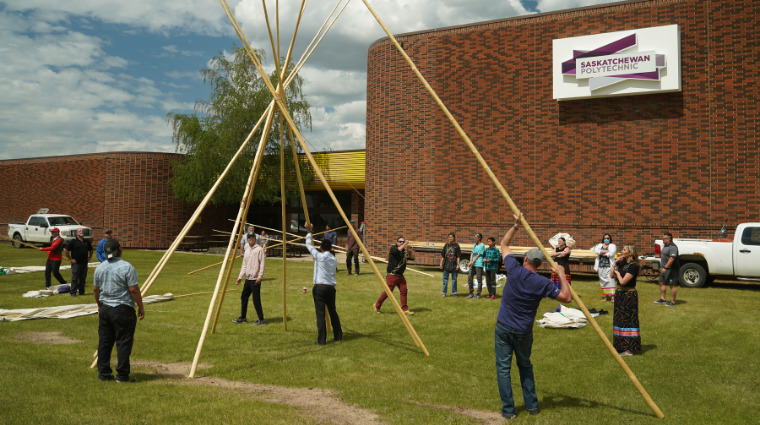
June is National Indigenous History Month, a significant month for Saskatchewan Polytechnic as it works toward reconciliation and incorporating Indigenous knowledge throughout the institution.
On June 7, faculty and staff, along with representatives from the Saskatchewan Wildlife Federation (SWF), came together for an Indigenous day of learning at Sask Polytech Prince Albert campus in preparation for the launch of a new Indigenous Learning Centre at the Hannin Creek Education and Applied Research Centre (HCEARC). A key feature of the new centre will be a set of traditional tipis. Under the guidance of five Knowledge Keepers from Wahpeton Dakota First Nation, participants learned all about the tipi—its meanings, protocols and the more practical aspect of how to raise one.
The tipis will be used in land-based education for a range of learners. Tipis are, by nature, portable structures, so before this can happen, Sask Polytech and its HCEARC partner, the SWF, needed to gain skills that would allow them to raise and lower the tipis through the seasons.
Tipi training is much more than just learning how to raise and lower the traditional portable structure common to the Indigenous people of the Plains and Great Lakes regions. Sask Polytech has a partnership with the Saskatchewan Indigenous Cultural Centre that allows it to access tipi teaching lesson plans. Further in-person guidance from the Prince Albert Grand Council (PAGC) Wahpeton Dakota First Nation ensured that the knowledge was transferred in the correct way, and that the training was more than just “book learning.”
The Wahpeton Dakota First Nation Knowledge Keepers began by sharing the beliefs and understandings about the tipi held by Indigenous people and passed from generation to generation. According to these teachings, the poles of the tipi represent the nations of people living upon Mother Earth and form the circle of life. Each one of the 13 poles also represents a trait to be honoured, starting with the three anchor poles that signify respect, obedience and humility. These anchors also symbolize the mother, father and child—and together, family balance. After the first three anchor poles comes the pole that completes the tipi’s doorway, representing happiness, followed by love, faith, kinship, cleanliness, thankfulness, sharing, strength, good child rearing and hope. The covering for the poles represents ultimate protection, and finally, 14 pins connect the tipi and keep it intact, like a family.
Deanna Speidel, Sask Polytech’s director of Indigenous Strategy attended the training with seven staff from her department. “It was hands-on learning,” she said. “They showed us and taught us the ways and then we did it. We now understand the proper way to raise a tipi with the understandings and beliefs of Whapeton Dakota First Nation. This was valuable learning for our team.”
Lorne Renouf also attended the training on behalf of the Integrated Resource Management program, and says he appreciated the chance for participants to set up a tipi by themselves. “First, we had the tarp inside out, so we had to do it again. We then set it up correctly and were timed at a little over 18 minutes. The experience was inspirational, and the knowledge gained was more than just a skill. It was a way of looking at how things were done. As I was buttonholing the pegs for the doors I couldn’t help but think that this has been done for centuries. This activity of putting up a tipi must have always been filled with happy anticipation—probably as a consequence of moving into a new area or hunting ground. The same feeling was shared today as I learned this new skill.”
David Yorke, president of SWF, notes that his organization purchased a tipi several years ago in conjunction with a local school division, saying, “We quickly recognized the fundamental nucleus it provided for education of First Nations traditions and historical knowledge that is a keystone of understanding and reconciliation. Today’s training ensured that we will properly honour and respect deeply rooted customs and traditions as we incorporate the tipi into our educational programming.”
The June 7 Indigenous day of learning was specifically planned for the upcoming tipi raising at Hannin Creek at the end of the month, but the knowledge transferred from Wahpeton Dakota First Nation has given Sask Polytech and SWF employees the understanding, skills and confidence to do it elsewhere. “Thank you to the Knowledge Keepers who have shared these important teachings with our community,” says Speidel. “We are honoured to accept this learning and excited to raise the tipis at Hannin Creek on June 30.”
A collaborative partnership between Sask Polytech and the SWF, Hannin Creek is situated in the boreal forest on the shores of Candle Lake, north of Prince Albert, Saskatchewan. Located on Treaty 6 Territory and homelands of the Métis, the centre is an important place for Sask Polytech’s School of Natural Resources and Built Environment, where students in a variety of programs including the Integrated Resource Management and Civil Engineering Technologies programs gain practical training. The centre is equally important to the many applied research projects that use it as a base.
Learn more about the Hannin Creek Education and Applied Research Centre.
Saskatchewan Polytechnic is signatory to the SDG Accord. Sustainable Development Goal alignment is one of the ways Sask Polytech is leading the rise of polytechnic education.

Published June 2022.

